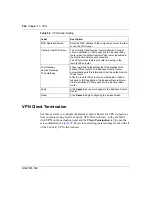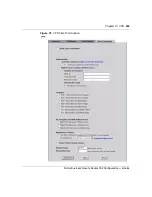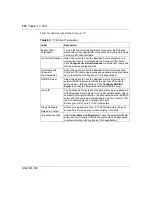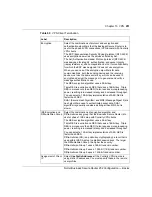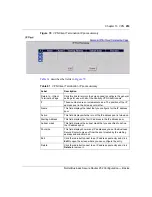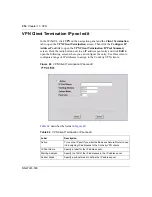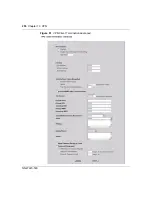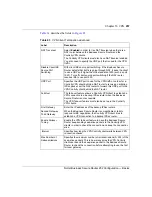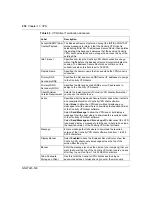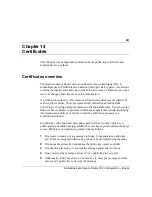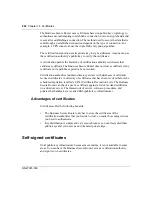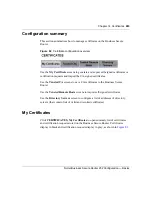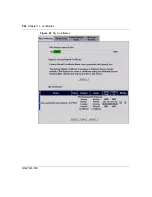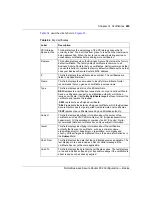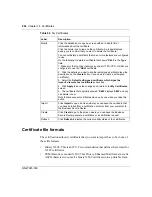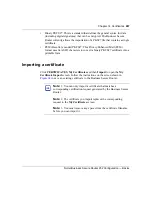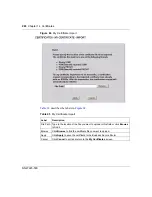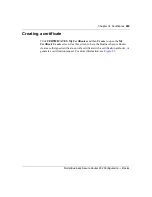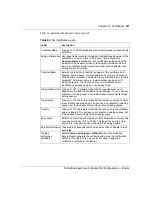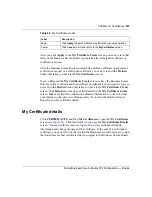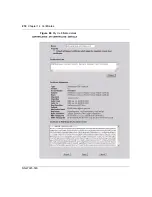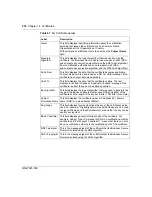
262
Chapter 14 Certificates
NN47923-500
The Business Secure Router uses certificates based on public-key cryptology to
authenticate users attempting to establish a connection, not to encrypt the data that
is sent after establishing a connection. The method used to secure the data that is
sent through an established connection depends on the type of connection. For
example, a VPN tunnel can use the triple DES encryption algorithm.
The certification authority uses its private key to sign certificates. Anyone can use
the certification authority’s public key to verify the certificates.
A certification path is the hierarchy of certification authority certificates that
validate a certificate. The Business Secure Router does not trust a certificate if any
certificate on its path has expired or been revoked.
Certification authorities maintain directory servers with databases of valid and
revoked certificates. A directory of certificates that have been revoked before the
scheduled expiration is called a CRL (Certificate Revocation List). The Business
Secure Router can check a peer’s certificate against a list of revoked certificates
on a directory server. The framework of servers, software, procedures, and
policies that handles keys is called PKI (public-key infrastructure).
Advantages of certificates
Certificates offer the following benefits:
•
The Business Secure Router only has to store the certificates of the
certification authorities that you decide to trust, no matter how many devices
you need to authenticate.
•
Key distribution is simple and very secure because you can freely distribute
public keys and you never need to transmit private keys.
Self-signed certificates
Until public-key infrastructure becomes more mature, it is not available in some
areas. You can have the Business Secure Router act as a certification authority
and sign its own certificates.
Summary of Contents for BSR252
Page 28: ...28 Tables NN47923 500 ...
Page 44: ...44 Chapter 1 Getting to know your Business Secure Router NN47923 500 ...
Page 52: ...52 Chapter 2 Introducing the WebGUI NN47923 500 ...
Page 70: ...70 Chapter 3 Wizard setup NN47923 500 ...
Page 96: ...96 Chapter 5 System screens NN47923 500 ...
Page 114: ...114 Chapter 7 WAN screens NN47923 500 Figure 27 WAN IP ...
Page 120: ...120 Chapter 7 WAN screens NN47923 500 Figure 31 Dial Backup Setup ...
Page 128: ...128 Chapter 7 WAN screens NN47923 500 ...
Page 152: ...152 Chapter 9 Static Route screens NN47923 500 ...
Page 194: ...194 Chapter 11 Firewall screens NN47923 500 ...
Page 210: ...210 Chapter 13 VPN NN47923 500 Figure 67 Summary IP Policies ...
Page 222: ...222 Chapter 13 VPN NN47923 500 Figure 71 VPN Branch Office rule setup ...
Page 256: ...256 Chapter 13 VPN NN47923 500 Figure 81 VPN Client Termination advanced ...
Page 260: ...260 Chapter 13 VPN NN47923 500 ...
Page 264: ...264 Chapter 14 Certificates NN47923 500 Figure 83 My Certificates ...
Page 270: ...270 Chapter 14 Certificates NN47923 500 Figure 85 My Certificate create ...
Page 274: ...274 Chapter 14 Certificates NN47923 500 Figure 86 My Certificate details ...
Page 282: ...282 Chapter 14 Certificates NN47923 500 Figure 89 Trusted CA details ...
Page 298: ...298 Chapter 14 Certificates NN47923 500 ...
Page 316: ...316 Chapter 16 IEEE 802 1x NN47923 500 ...
Page 320: ...320 Chapter 17 Authentication server NN47923 500 Figure 106 Local User database edit ...
Page 328: ...328 Chapter 17 Authentication server NN47923 500 ...
Page 376: ...376 Chapter 20 Logs Screens NN47923 500 Figure 150 Log settings ...
Page 386: ...386 Chapter 20 Logs Screens NN47923 500 ...
Page 393: ...Chapter 21 Call scheduling screens 393 Nortel Business Secure Router 252 Configuration Basics ...
Page 394: ...394 Chapter 21 Call scheduling screens NN47923 500 ...
Page 410: ...410 Chapter 22 Maintenance NN47923 500 ...

